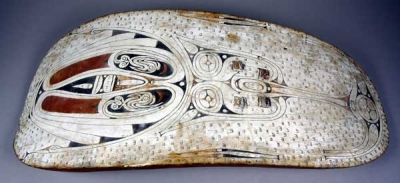War shield (1893.68.1)
 Trobriand IslandsWar shield from the Trobriand Islands, Oceania. Collector not known. Purchased by the Museum from Stevens Auction Rooms in 1893.
Trobriand IslandsWar shield from the Trobriand Islands, Oceania. Collector not known. Purchased by the Museum from Stevens Auction Rooms in 1893.
This wooden war-shield comes from the Trobriand Islands, a group of coral atoll islands off the eastern tip of Papua New Guinea.
The shield is of a convex, oval shape with a double cane grip on the back, which is painted red. On the front it is painted with typical curvilinear designs using the local artistic colour scheme - red, black and white. Although the designs are always similar, no two shields are ever exactly the same.
Sacred Weapons
Warfare in the Trobriand Islands was pursued with long thrown spears (four metres or more in length), wooden clubs, and shields such as these. Before Trobriands men went to war, the village magician would cast a spell over each shield by resting it on his knees, and whispering his spell into the decorated surface from a few centimetres away, empowering it with his breath. As a result, the shield became impervious to spears. Therefore, the painted designs were conceived to have magical powers that could be invoked to help ensure survival and success in combat.
There has been a great amount of debate over the meaning of the decoration on Trobriand Islands shields. Some scholars have seen the design as representing a flying witch called a mulukuausi, the most fearful thing in Trobriands mythology, which would terrify the enemy. Others have interpreted the shields as showing a husband and wife having sexual intercourse, which is considered an obscene visual insult. It is possible that a number of culturally important animals such as hornbills and snakes are shown. Still other experts think the shield designs represent a single human figure, much like the shell-inlaid human figures on high-status shields from the nearby Solomon Islands. In this interpretation, the three major 'zones' of the shield represent the figure's head, throat and abdomen. The Trobriand Islanders traditionally understood magical power to reside in the belly, and it has been suggested that the design represents the path by which a magician sends his power out into the world from inside his body.





